The History and Impact of Mathematics on the UK National Curriculum
VerifiedAdded on 2023/03/17
|36
|13635
|67
Project
AI Summary
This research project delves into the historical evolution and impact of mathematics on the UK national curriculum. It begins with an introduction outlining the consistent efforts for change and the limited observed progress in secondary school mathematics education since the early twentieth century. The project explores the background of the study, problem statement, rationale, research objectives and questions, followed by an extensive literature review. The literature review examines the key influences on contemporary mathematics national curriculum. The methodology section outlines the research approach, including research philosophy, design, approach, data type, collection methods, and ethical considerations. The discussion section analyzes the findings and their implications, leading to conclusions and recommendations for future curriculum development. The project highlights key changes in the curriculum and their impact on students and the education system. The project also includes an analysis of the role of teachers and various factors that influence the mathematics curriculum in the UK. The research utilizes secondary data and literature review as a methodology to explore the development and key changes in the mathematics curriculum.
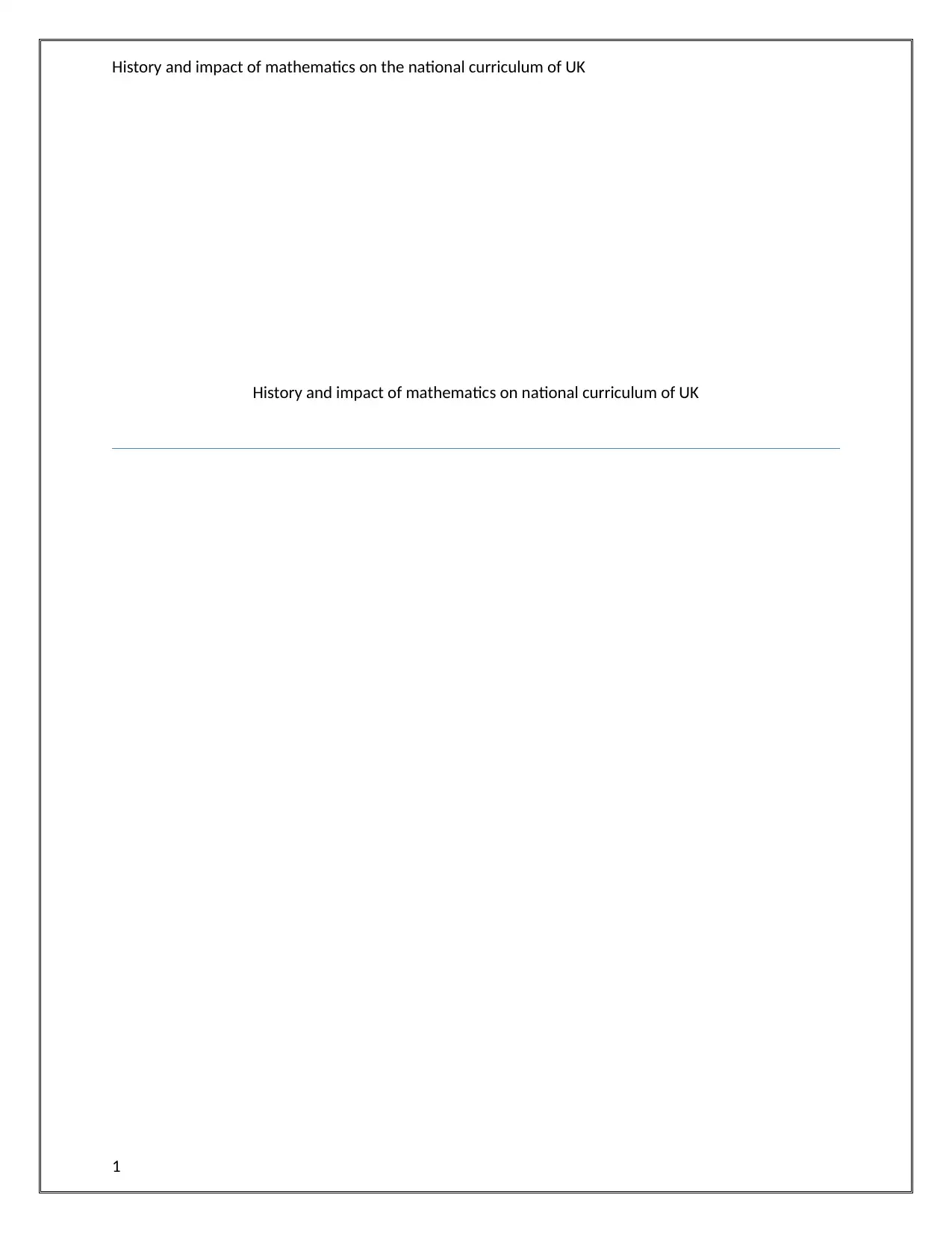
History and impact of mathematics on the national curriculum of UK
History and impact of mathematics on national curriculum of UK
1
History and impact of mathematics on national curriculum of UK
1
Paraphrase This Document
Need a fresh take? Get an instant paraphrase of this document with our AI Paraphraser
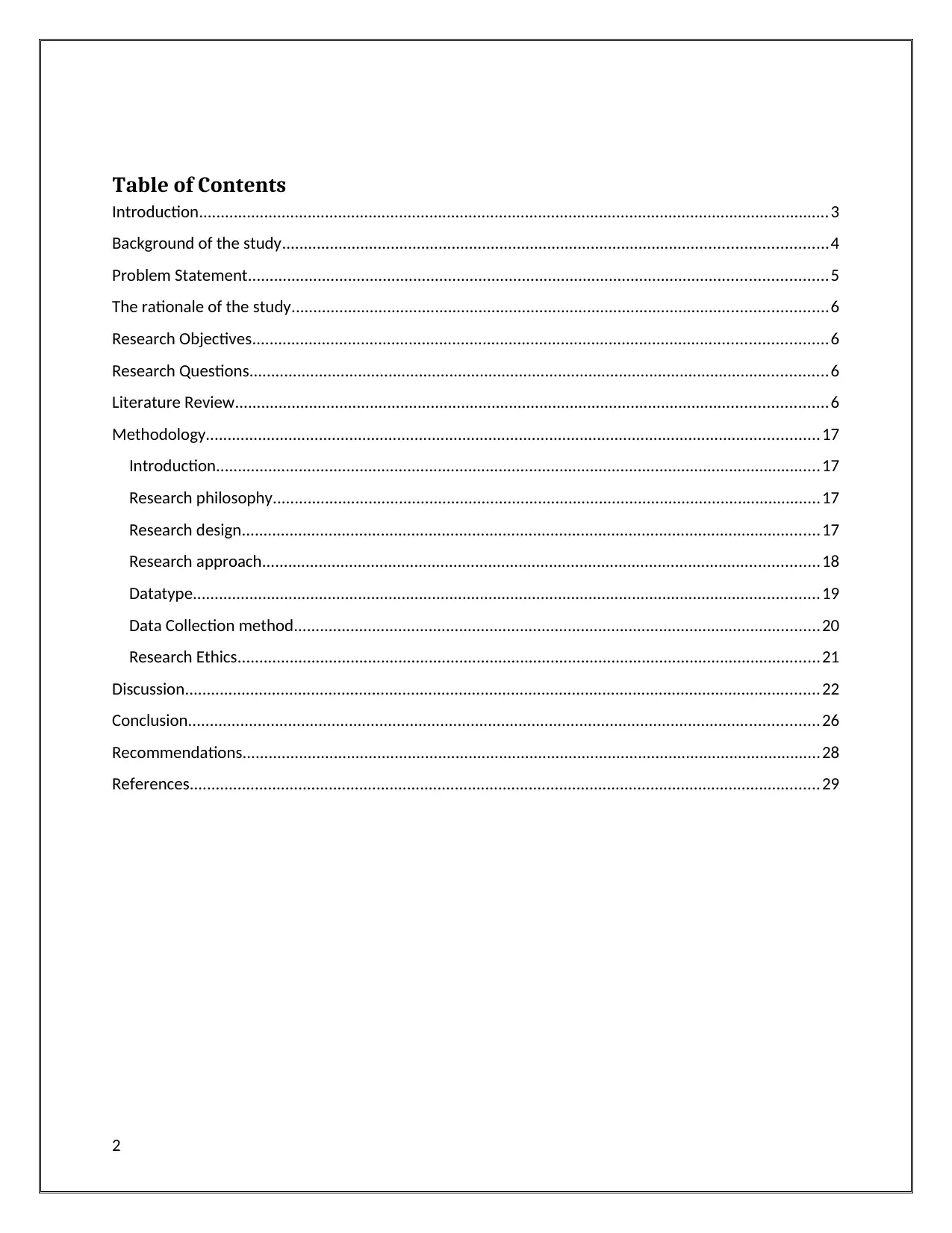
Table of Contents
Introduction.................................................................................................................................................3
Background of the study.............................................................................................................................4
Problem Statement.....................................................................................................................................5
The rationale of the study...........................................................................................................................6
Research Objectives....................................................................................................................................6
Research Questions.....................................................................................................................................6
Literature Review........................................................................................................................................6
Methodology.............................................................................................................................................17
Introduction...........................................................................................................................................17
Research philosophy..............................................................................................................................17
Research design.....................................................................................................................................17
Research approach................................................................................................................................18
Datatype................................................................................................................................................19
Data Collection method.........................................................................................................................20
Research Ethics......................................................................................................................................21
Discussion..................................................................................................................................................22
Conclusion.................................................................................................................................................26
Recommendations.....................................................................................................................................28
References.................................................................................................................................................29
2
Introduction.................................................................................................................................................3
Background of the study.............................................................................................................................4
Problem Statement.....................................................................................................................................5
The rationale of the study...........................................................................................................................6
Research Objectives....................................................................................................................................6
Research Questions.....................................................................................................................................6
Literature Review........................................................................................................................................6
Methodology.............................................................................................................................................17
Introduction...........................................................................................................................................17
Research philosophy..............................................................................................................................17
Research design.....................................................................................................................................17
Research approach................................................................................................................................18
Datatype................................................................................................................................................19
Data Collection method.........................................................................................................................20
Research Ethics......................................................................................................................................21
Discussion..................................................................................................................................................22
Conclusion.................................................................................................................................................26
Recommendations.....................................................................................................................................28
References.................................................................................................................................................29
2
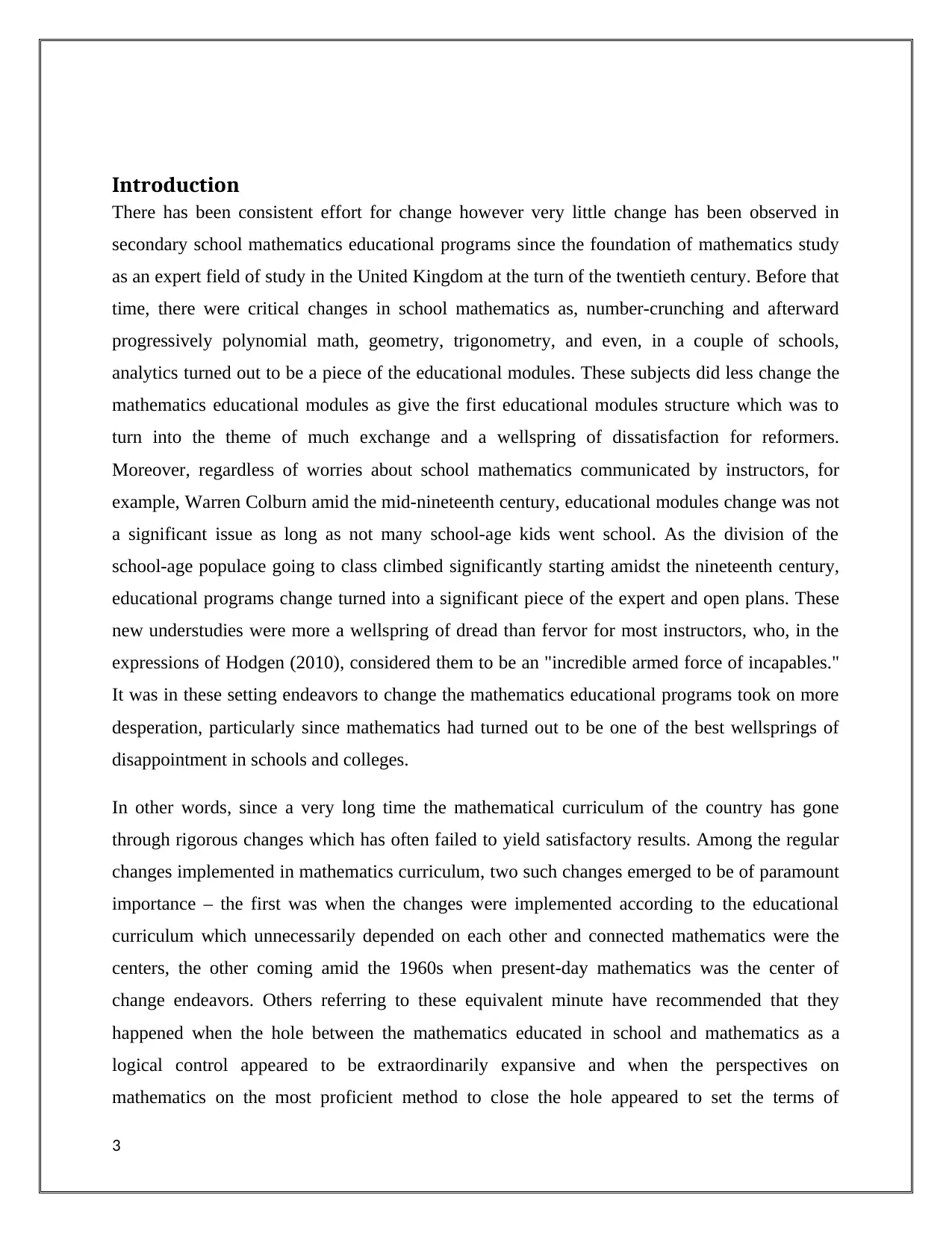
Introduction
There has been consistent effort for change however very little change has been observed in
secondary school mathematics educational programs since the foundation of mathematics study
as an expert field of study in the United Kingdom at the turn of the twentieth century. Before that
time, there were critical changes in school mathematics as, number-crunching and afterward
progressively polynomial math, geometry, trigonometry, and even, in a couple of schools,
analytics turned out to be a piece of the educational modules. These subjects did less change the
mathematics educational modules as give the first educational modules structure which was to
turn into the theme of much exchange and a wellspring of dissatisfaction for reformers.
Moreover, regardless of worries about school mathematics communicated by instructors, for
example, Warren Colburn amid the mid-nineteenth century, educational modules change was not
a significant issue as long as not many school-age kids went school. As the division of the
school-age populace going to class climbed significantly starting amidst the nineteenth century,
educational programs change turned into a significant piece of the expert and open plans. These
new understudies were more a wellspring of dread than fervor for most instructors, who, in the
expressions of Hodgen (2010), considered them to be an "incredible armed force of incapables."
It was in these setting endeavors to change the mathematics educational programs took on more
desperation, particularly since mathematics had turned out to be one of the best wellsprings of
disappointment in schools and colleges.
In other words, since a very long time the mathematical curriculum of the country has gone
through rigorous changes which has often failed to yield satisfactory results. Among the regular
changes implemented in mathematics curriculum, two such changes emerged to be of paramount
importance – the first was when the changes were implemented according to the educational
curriculum which unnecessarily depended on each other and connected mathematics were the
centers, the other coming amid the 1960s when present-day mathematics was the center of
change endeavors. Others referring to these equivalent minute have recommended that they
happened when the hole between the mathematics educated in school and mathematics as a
logical control appeared to be extraordinarily expansive and when the perspectives on
mathematics on the most proficient method to close the hole appeared to set the terms of
3
There has been consistent effort for change however very little change has been observed in
secondary school mathematics educational programs since the foundation of mathematics study
as an expert field of study in the United Kingdom at the turn of the twentieth century. Before that
time, there were critical changes in school mathematics as, number-crunching and afterward
progressively polynomial math, geometry, trigonometry, and even, in a couple of schools,
analytics turned out to be a piece of the educational modules. These subjects did less change the
mathematics educational modules as give the first educational modules structure which was to
turn into the theme of much exchange and a wellspring of dissatisfaction for reformers.
Moreover, regardless of worries about school mathematics communicated by instructors, for
example, Warren Colburn amid the mid-nineteenth century, educational modules change was not
a significant issue as long as not many school-age kids went school. As the division of the
school-age populace going to class climbed significantly starting amidst the nineteenth century,
educational programs change turned into a significant piece of the expert and open plans. These
new understudies were more a wellspring of dread than fervor for most instructors, who, in the
expressions of Hodgen (2010), considered them to be an "incredible armed force of incapables."
It was in these setting endeavors to change the mathematics educational programs took on more
desperation, particularly since mathematics had turned out to be one of the best wellsprings of
disappointment in schools and colleges.
In other words, since a very long time the mathematical curriculum of the country has gone
through rigorous changes which has often failed to yield satisfactory results. Among the regular
changes implemented in mathematics curriculum, two such changes emerged to be of paramount
importance – the first was when the changes were implemented according to the educational
curriculum which unnecessarily depended on each other and connected mathematics were the
centers, the other coming amid the 1960s when present-day mathematics was the center of
change endeavors. Others referring to these equivalent minute have recommended that they
happened when the hole between the mathematics educated in school and mathematics as a
logical control appeared to be extraordinarily expansive and when the perspectives on
mathematics on the most proficient method to close the hole appeared to set the terms of
3
⊘ This is a preview!⊘
Do you want full access?
Subscribe today to unlock all pages.

Trusted by 1+ million students worldwide
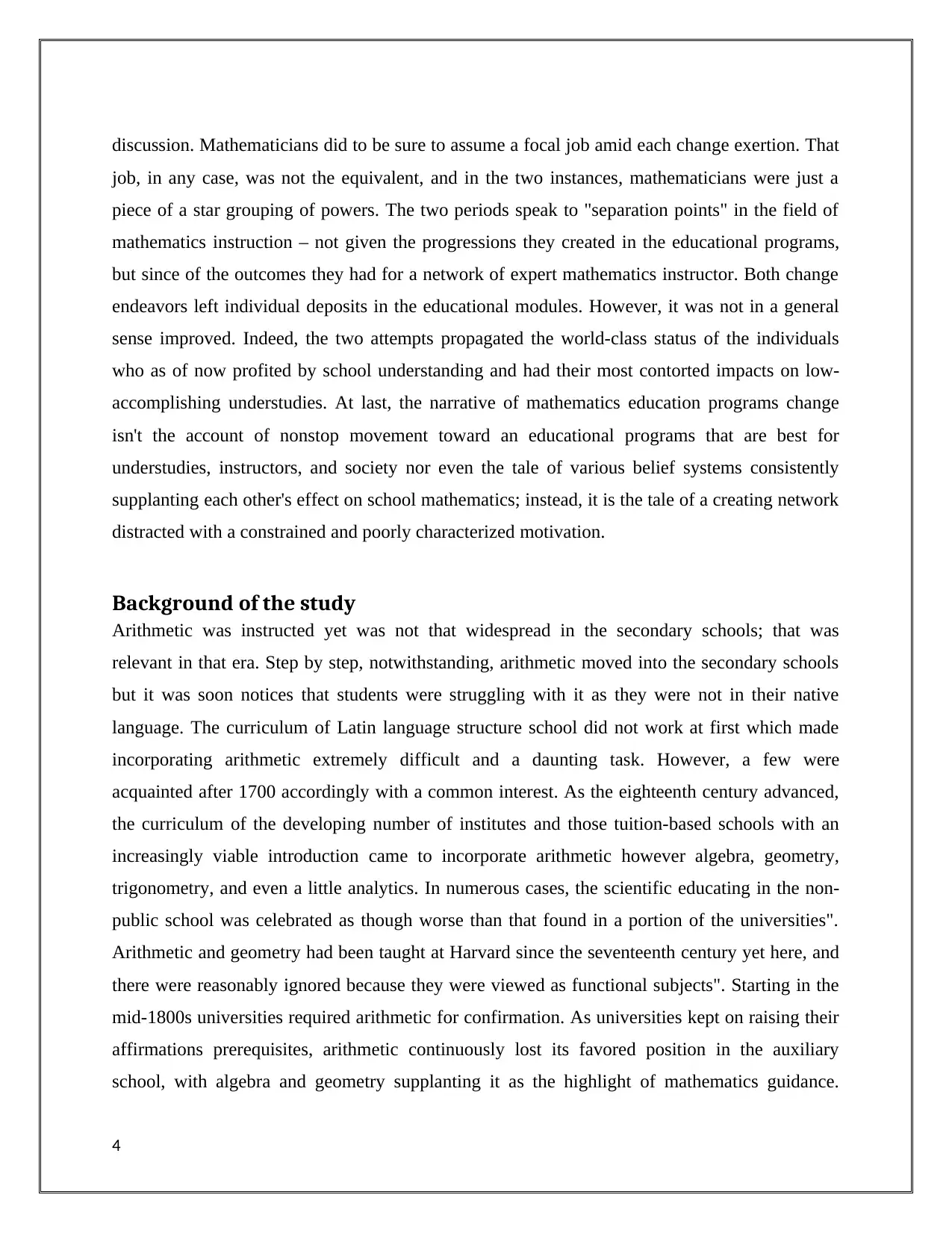
discussion. Mathematicians did to be sure to assume a focal job amid each change exertion. That
job, in any case, was not the equivalent, and in the two instances, mathematicians were just a
piece of a star grouping of powers. The two periods speak to "separation points" in the field of
mathematics instruction – not given the progressions they created in the educational programs,
but since of the outcomes they had for a network of expert mathematics instructor. Both change
endeavors left individual deposits in the educational modules. However, it was not in a general
sense improved. Indeed, the two attempts propagated the world-class status of the individuals
who as of now profited by school understanding and had their most contorted impacts on low-
accomplishing understudies. At last, the narrative of mathematics education programs change
isn't the account of nonstop movement toward an educational programs that are best for
understudies, instructors, and society nor even the tale of various belief systems consistently
supplanting each other's effect on school mathematics; instead, it is the tale of a creating network
distracted with a constrained and poorly characterized motivation.
Background of the study
Arithmetic was instructed yet was not that widespread in the secondary schools; that was
relevant in that era. Step by step, notwithstanding, arithmetic moved into the secondary schools
but it was soon notices that students were struggling with it as they were not in their native
language. The curriculum of Latin language structure school did not work at first which made
incorporating arithmetic extremely difficult and a daunting task. However, a few were
acquainted after 1700 accordingly with a common interest. As the eighteenth century advanced,
the curriculum of the developing number of institutes and those tuition-based schools with an
increasingly viable introduction came to incorporate arithmetic however algebra, geometry,
trigonometry, and even a little analytics. In numerous cases, the scientific educating in the non-
public school was celebrated as though worse than that found in a portion of the universities".
Arithmetic and geometry had been taught at Harvard since the seventeenth century yet here, and
there were reasonably ignored because they were viewed as functional subjects". Starting in the
mid-1800s universities required arithmetic for confirmation. As universities kept on raising their
affirmations prerequisites, arithmetic continuously lost its favored position in the auxiliary
school, with algebra and geometry supplanting it as the highlight of mathematics guidance.
4
job, in any case, was not the equivalent, and in the two instances, mathematicians were just a
piece of a star grouping of powers. The two periods speak to "separation points" in the field of
mathematics instruction – not given the progressions they created in the educational programs,
but since of the outcomes they had for a network of expert mathematics instructor. Both change
endeavors left individual deposits in the educational modules. However, it was not in a general
sense improved. Indeed, the two attempts propagated the world-class status of the individuals
who as of now profited by school understanding and had their most contorted impacts on low-
accomplishing understudies. At last, the narrative of mathematics education programs change
isn't the account of nonstop movement toward an educational programs that are best for
understudies, instructors, and society nor even the tale of various belief systems consistently
supplanting each other's effect on school mathematics; instead, it is the tale of a creating network
distracted with a constrained and poorly characterized motivation.
Background of the study
Arithmetic was instructed yet was not that widespread in the secondary schools; that was
relevant in that era. Step by step, notwithstanding, arithmetic moved into the secondary schools
but it was soon notices that students were struggling with it as they were not in their native
language. The curriculum of Latin language structure school did not work at first which made
incorporating arithmetic extremely difficult and a daunting task. However, a few were
acquainted after 1700 accordingly with a common interest. As the eighteenth century advanced,
the curriculum of the developing number of institutes and those tuition-based schools with an
increasingly viable introduction came to incorporate arithmetic however algebra, geometry,
trigonometry, and even a little analytics. In numerous cases, the scientific educating in the non-
public school was celebrated as though worse than that found in a portion of the universities".
Arithmetic and geometry had been taught at Harvard since the seventeenth century yet here, and
there were reasonably ignored because they were viewed as functional subjects". Starting in the
mid-1800s universities required arithmetic for confirmation. As universities kept on raising their
affirmations prerequisites, arithmetic continuously lost its favored position in the auxiliary
school, with algebra and geometry supplanting it as the highlight of mathematics guidance.
4
Paraphrase This Document
Need a fresh take? Get an instant paraphrase of this document with our AI Paraphraser
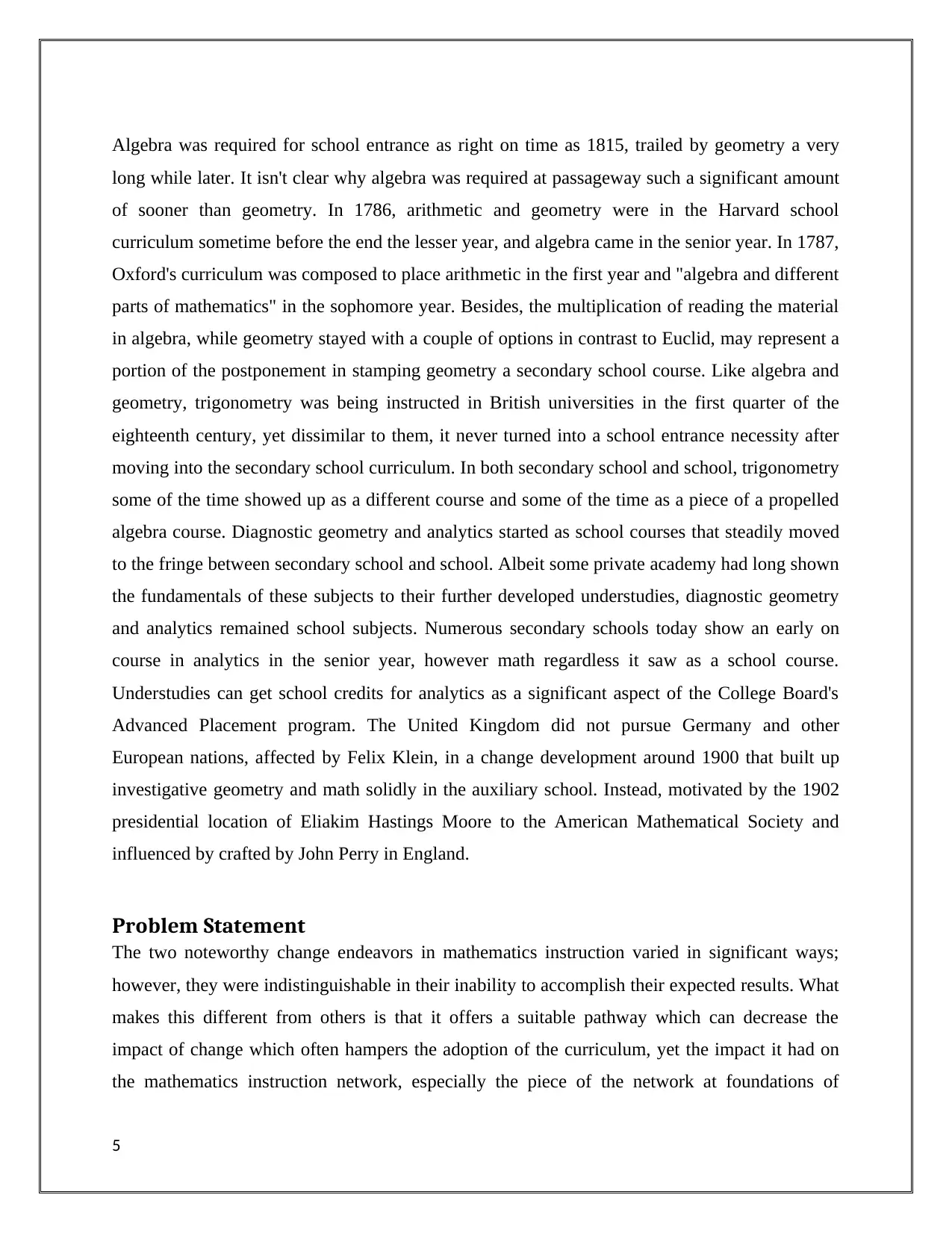
Algebra was required for school entrance as right on time as 1815, trailed by geometry a very
long while later. It isn't clear why algebra was required at passageway such a significant amount
of sooner than geometry. In 1786, arithmetic and geometry were in the Harvard school
curriculum sometime before the end the lesser year, and algebra came in the senior year. In 1787,
Oxford's curriculum was composed to place arithmetic in the first year and "algebra and different
parts of mathematics" in the sophomore year. Besides, the multiplication of reading the material
in algebra, while geometry stayed with a couple of options in contrast to Euclid, may represent a
portion of the postponement in stamping geometry a secondary school course. Like algebra and
geometry, trigonometry was being instructed in British universities in the first quarter of the
eighteenth century, yet dissimilar to them, it never turned into a school entrance necessity after
moving into the secondary school curriculum. In both secondary school and school, trigonometry
some of the time showed up as a different course and some of the time as a piece of a propelled
algebra course. Diagnostic geometry and analytics started as school courses that steadily moved
to the fringe between secondary school and school. Albeit some private academy had long shown
the fundamentals of these subjects to their further developed understudies, diagnostic geometry
and analytics remained school subjects. Numerous secondary schools today show an early on
course in analytics in the senior year, however math regardless it saw as a school course.
Understudies can get school credits for analytics as a significant aspect of the College Board's
Advanced Placement program. The United Kingdom did not pursue Germany and other
European nations, affected by Felix Klein, in a change development around 1900 that built up
investigative geometry and math solidly in the auxiliary school. Instead, motivated by the 1902
presidential location of Eliakim Hastings Moore to the American Mathematical Society and
influenced by crafted by John Perry in England.
Problem Statement
The two noteworthy change endeavors in mathematics instruction varied in significant ways;
however, they were indistinguishable in their inability to accomplish their expected results. What
makes this different from others is that it offers a suitable pathway which can decrease the
impact of change which often hampers the adoption of the curriculum, yet the impact it had on
the mathematics instruction network, especially the piece of the network at foundations of
5
long while later. It isn't clear why algebra was required at passageway such a significant amount
of sooner than geometry. In 1786, arithmetic and geometry were in the Harvard school
curriculum sometime before the end the lesser year, and algebra came in the senior year. In 1787,
Oxford's curriculum was composed to place arithmetic in the first year and "algebra and different
parts of mathematics" in the sophomore year. Besides, the multiplication of reading the material
in algebra, while geometry stayed with a couple of options in contrast to Euclid, may represent a
portion of the postponement in stamping geometry a secondary school course. Like algebra and
geometry, trigonometry was being instructed in British universities in the first quarter of the
eighteenth century, yet dissimilar to them, it never turned into a school entrance necessity after
moving into the secondary school curriculum. In both secondary school and school, trigonometry
some of the time showed up as a different course and some of the time as a piece of a propelled
algebra course. Diagnostic geometry and analytics started as school courses that steadily moved
to the fringe between secondary school and school. Albeit some private academy had long shown
the fundamentals of these subjects to their further developed understudies, diagnostic geometry
and analytics remained school subjects. Numerous secondary schools today show an early on
course in analytics in the senior year, however math regardless it saw as a school course.
Understudies can get school credits for analytics as a significant aspect of the College Board's
Advanced Placement program. The United Kingdom did not pursue Germany and other
European nations, affected by Felix Klein, in a change development around 1900 that built up
investigative geometry and math solidly in the auxiliary school. Instead, motivated by the 1902
presidential location of Eliakim Hastings Moore to the American Mathematical Society and
influenced by crafted by John Perry in England.
Problem Statement
The two noteworthy change endeavors in mathematics instruction varied in significant ways;
however, they were indistinguishable in their inability to accomplish their expected results. What
makes this different from others is that it offers a suitable pathway which can decrease the
impact of change which often hampers the adoption of the curriculum, yet the impact it had on
the mathematics instruction network, especially the piece of the network at foundations of
5
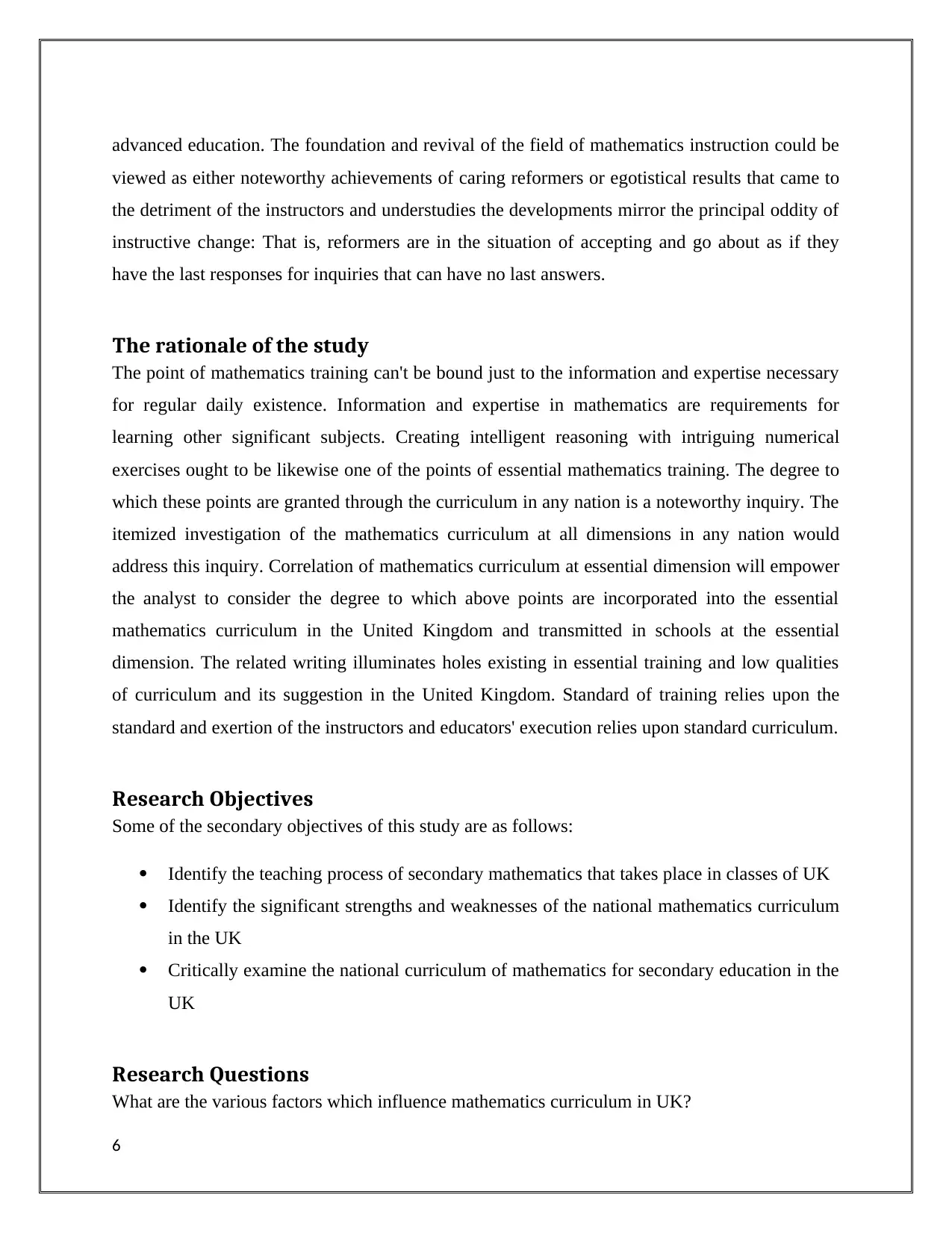
advanced education. The foundation and revival of the field of mathematics instruction could be
viewed as either noteworthy achievements of caring reformers or egotistical results that came to
the detriment of the instructors and understudies the developments mirror the principal oddity of
instructive change: That is, reformers are in the situation of accepting and go about as if they
have the last responses for inquiries that can have no last answers.
The rationale of the study
The point of mathematics training can't be bound just to the information and expertise necessary
for regular daily existence. Information and expertise in mathematics are requirements for
learning other significant subjects. Creating intelligent reasoning with intriguing numerical
exercises ought to be likewise one of the points of essential mathematics training. The degree to
which these points are granted through the curriculum in any nation is a noteworthy inquiry. The
itemized investigation of the mathematics curriculum at all dimensions in any nation would
address this inquiry. Correlation of mathematics curriculum at essential dimension will empower
the analyst to consider the degree to which above points are incorporated into the essential
mathematics curriculum in the United Kingdom and transmitted in schools at the essential
dimension. The related writing illuminates holes existing in essential training and low qualities
of curriculum and its suggestion in the United Kingdom. Standard of training relies upon the
standard and exertion of the instructors and educators' execution relies upon standard curriculum.
Research Objectives
Some of the secondary objectives of this study are as follows:
Identify the teaching process of secondary mathematics that takes place in classes of UK
Identify the significant strengths and weaknesses of the national mathematics curriculum
in the UK
Critically examine the national curriculum of mathematics for secondary education in the
UK
Research Questions
What are the various factors which influence mathematics curriculum in UK?
6
viewed as either noteworthy achievements of caring reformers or egotistical results that came to
the detriment of the instructors and understudies the developments mirror the principal oddity of
instructive change: That is, reformers are in the situation of accepting and go about as if they
have the last responses for inquiries that can have no last answers.
The rationale of the study
The point of mathematics training can't be bound just to the information and expertise necessary
for regular daily existence. Information and expertise in mathematics are requirements for
learning other significant subjects. Creating intelligent reasoning with intriguing numerical
exercises ought to be likewise one of the points of essential mathematics training. The degree to
which these points are granted through the curriculum in any nation is a noteworthy inquiry. The
itemized investigation of the mathematics curriculum at all dimensions in any nation would
address this inquiry. Correlation of mathematics curriculum at essential dimension will empower
the analyst to consider the degree to which above points are incorporated into the essential
mathematics curriculum in the United Kingdom and transmitted in schools at the essential
dimension. The related writing illuminates holes existing in essential training and low qualities
of curriculum and its suggestion in the United Kingdom. Standard of training relies upon the
standard and exertion of the instructors and educators' execution relies upon standard curriculum.
Research Objectives
Some of the secondary objectives of this study are as follows:
Identify the teaching process of secondary mathematics that takes place in classes of UK
Identify the significant strengths and weaknesses of the national mathematics curriculum
in the UK
Critically examine the national curriculum of mathematics for secondary education in the
UK
Research Questions
What are the various factors which influence mathematics curriculum in UK?
6
⊘ This is a preview!⊘
Do you want full access?
Subscribe today to unlock all pages.

Trusted by 1+ million students worldwide
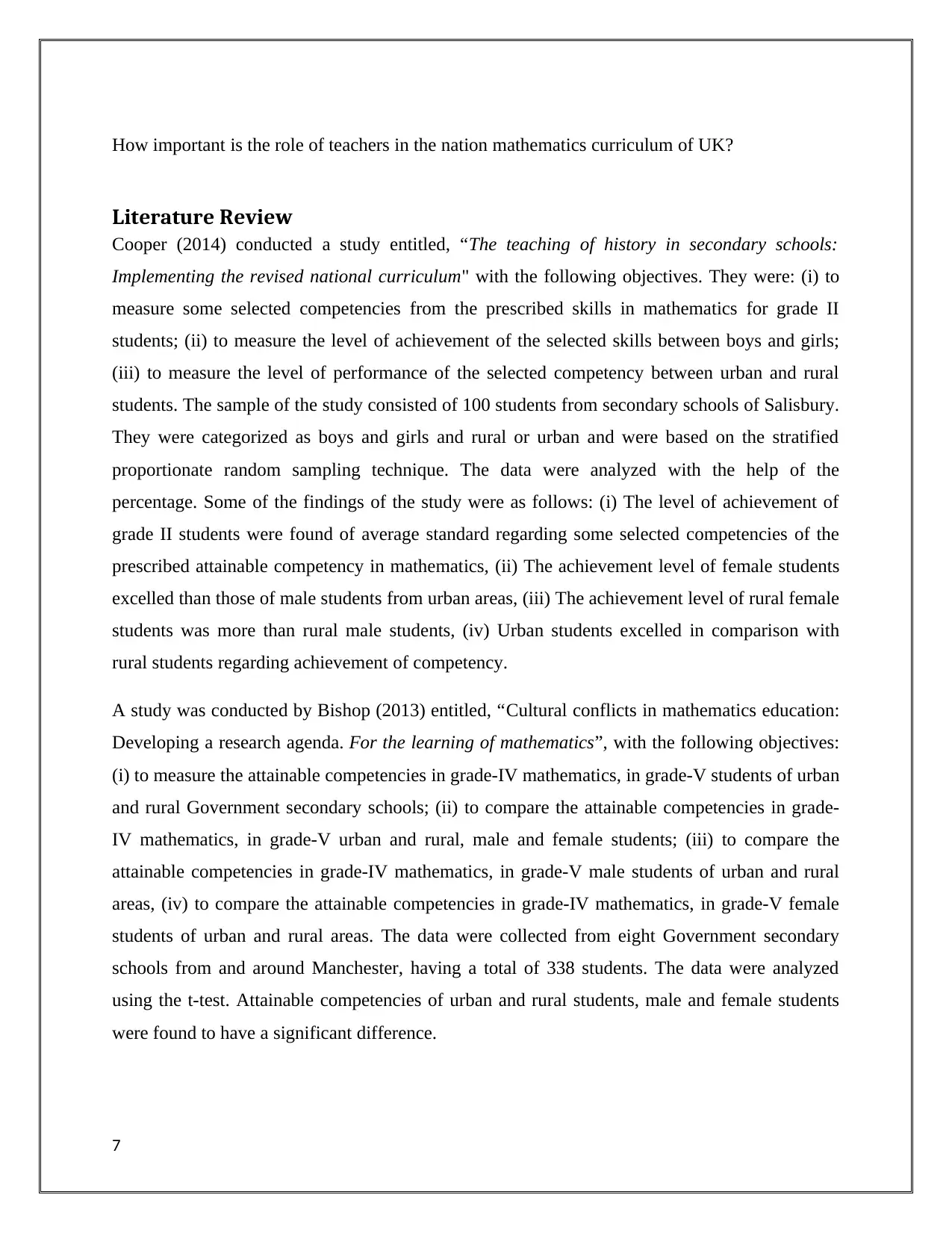
How important is the role of teachers in the nation mathematics curriculum of UK?
Literature Review
Cooper (2014) conducted a study entitled, “The teaching of history in secondary schools:
Implementing the revised national curriculum" with the following objectives. They were: (i) to
measure some selected competencies from the prescribed skills in mathematics for grade II
students; (ii) to measure the level of achievement of the selected skills between boys and girls;
(iii) to measure the level of performance of the selected competency between urban and rural
students. The sample of the study consisted of 100 students from secondary schools of Salisbury.
They were categorized as boys and girls and rural or urban and were based on the stratified
proportionate random sampling technique. The data were analyzed with the help of the
percentage. Some of the findings of the study were as follows: (i) The level of achievement of
grade II students were found of average standard regarding some selected competencies of the
prescribed attainable competency in mathematics, (ii) The achievement level of female students
excelled than those of male students from urban areas, (iii) The achievement level of rural female
students was more than rural male students, (iv) Urban students excelled in comparison with
rural students regarding achievement of competency.
A study was conducted by Bishop (2013) entitled, “Cultural conflicts in mathematics education:
Developing a research agenda. For the learning of mathematics”, with the following objectives:
(i) to measure the attainable competencies in grade-IV mathematics, in grade-V students of urban
and rural Government secondary schools; (ii) to compare the attainable competencies in grade-
IV mathematics, in grade-V urban and rural, male and female students; (iii) to compare the
attainable competencies in grade-IV mathematics, in grade-V male students of urban and rural
areas, (iv) to compare the attainable competencies in grade-IV mathematics, in grade-V female
students of urban and rural areas. The data were collected from eight Government secondary
schools from and around Manchester, having a total of 338 students. The data were analyzed
using the t-test. Attainable competencies of urban and rural students, male and female students
were found to have a significant difference.
7
Literature Review
Cooper (2014) conducted a study entitled, “The teaching of history in secondary schools:
Implementing the revised national curriculum" with the following objectives. They were: (i) to
measure some selected competencies from the prescribed skills in mathematics for grade II
students; (ii) to measure the level of achievement of the selected skills between boys and girls;
(iii) to measure the level of performance of the selected competency between urban and rural
students. The sample of the study consisted of 100 students from secondary schools of Salisbury.
They were categorized as boys and girls and rural or urban and were based on the stratified
proportionate random sampling technique. The data were analyzed with the help of the
percentage. Some of the findings of the study were as follows: (i) The level of achievement of
grade II students were found of average standard regarding some selected competencies of the
prescribed attainable competency in mathematics, (ii) The achievement level of female students
excelled than those of male students from urban areas, (iii) The achievement level of rural female
students was more than rural male students, (iv) Urban students excelled in comparison with
rural students regarding achievement of competency.
A study was conducted by Bishop (2013) entitled, “Cultural conflicts in mathematics education:
Developing a research agenda. For the learning of mathematics”, with the following objectives:
(i) to measure the attainable competencies in grade-IV mathematics, in grade-V students of urban
and rural Government secondary schools; (ii) to compare the attainable competencies in grade-
IV mathematics, in grade-V urban and rural, male and female students; (iii) to compare the
attainable competencies in grade-IV mathematics, in grade-V male students of urban and rural
areas, (iv) to compare the attainable competencies in grade-IV mathematics, in grade-V female
students of urban and rural areas. The data were collected from eight Government secondary
schools from and around Manchester, having a total of 338 students. The data were analyzed
using the t-test. Attainable competencies of urban and rural students, male and female students
were found to have a significant difference.
7
Paraphrase This Document
Need a fresh take? Get an instant paraphrase of this document with our AI Paraphraser
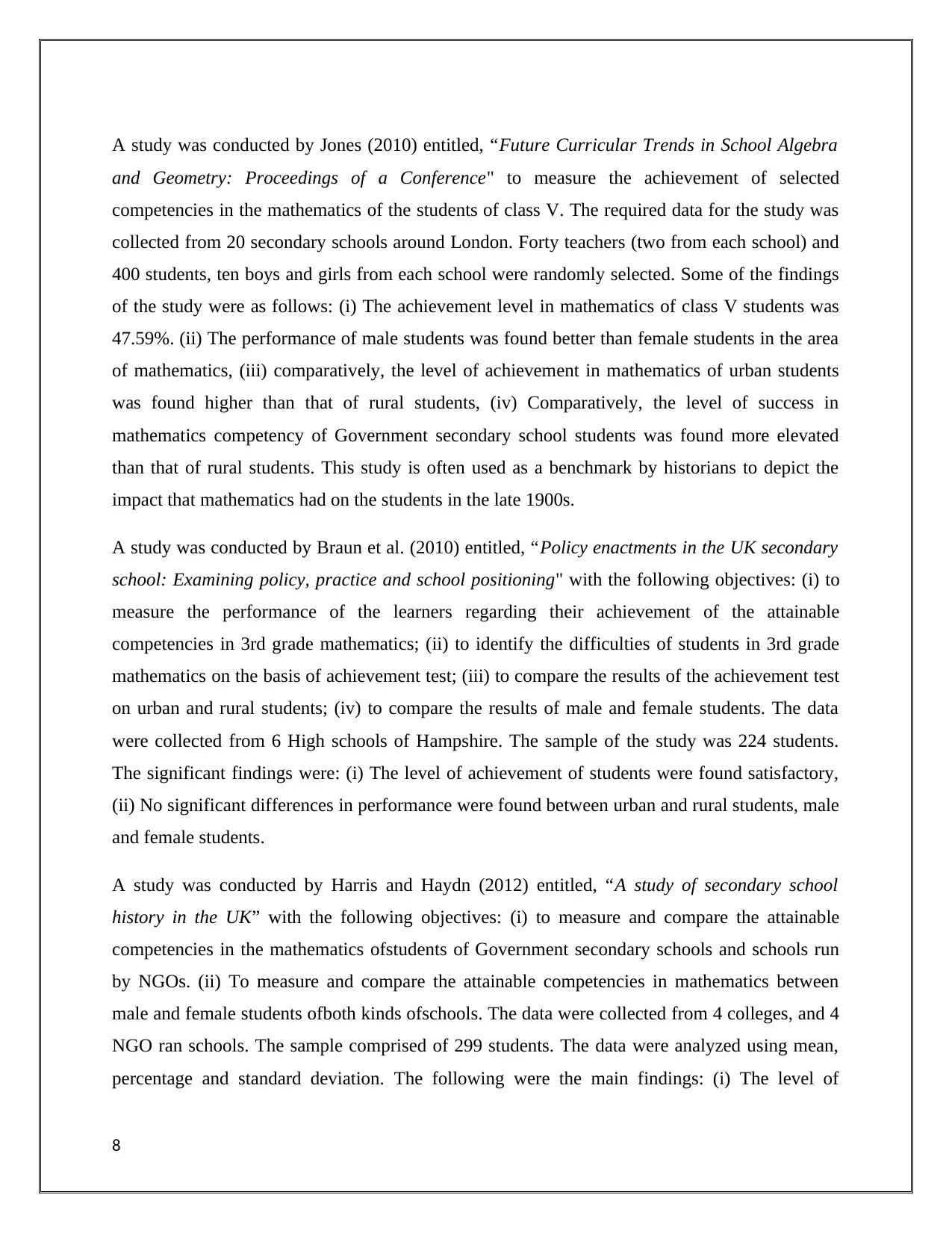
A study was conducted by Jones (2010) entitled, “Future Curricular Trends in School Algebra
and Geometry: Proceedings of a Conference" to measure the achievement of selected
competencies in the mathematics of the students of class V. The required data for the study was
collected from 20 secondary schools around London. Forty teachers (two from each school) and
400 students, ten boys and girls from each school were randomly selected. Some of the findings
of the study were as follows: (i) The achievement level in mathematics of class V students was
47.59%. (ii) The performance of male students was found better than female students in the area
of mathematics, (iii) comparatively, the level of achievement in mathematics of urban students
was found higher than that of rural students, (iv) Comparatively, the level of success in
mathematics competency of Government secondary school students was found more elevated
than that of rural students. This study is often used as a benchmark by historians to depict the
impact that mathematics had on the students in the late 1900s.
A study was conducted by Braun et al. (2010) entitled, “Policy enactments in the UK secondary
school: Examining policy, practice and school positioning" with the following objectives: (i) to
measure the performance of the learners regarding their achievement of the attainable
competencies in 3rd grade mathematics; (ii) to identify the difficulties of students in 3rd grade
mathematics on the basis of achievement test; (iii) to compare the results of the achievement test
on urban and rural students; (iv) to compare the results of male and female students. The data
were collected from 6 High schools of Hampshire. The sample of the study was 224 students.
The significant findings were: (i) The level of achievement of students were found satisfactory,
(ii) No significant differences in performance were found between urban and rural students, male
and female students.
A study was conducted by Harris and Haydn (2012) entitled, “A study of secondary school
history in the UK” with the following objectives: (i) to measure and compare the attainable
competencies in the mathematics ofstudents of Government secondary schools and schools run
by NGOs. (ii) To measure and compare the attainable competencies in mathematics between
male and female students ofboth kinds ofschools. The data were collected from 4 colleges, and 4
NGO ran schools. The sample comprised of 299 students. The data were analyzed using mean,
percentage and standard deviation. The following were the main findings: (i) The level of
8
and Geometry: Proceedings of a Conference" to measure the achievement of selected
competencies in the mathematics of the students of class V. The required data for the study was
collected from 20 secondary schools around London. Forty teachers (two from each school) and
400 students, ten boys and girls from each school were randomly selected. Some of the findings
of the study were as follows: (i) The achievement level in mathematics of class V students was
47.59%. (ii) The performance of male students was found better than female students in the area
of mathematics, (iii) comparatively, the level of achievement in mathematics of urban students
was found higher than that of rural students, (iv) Comparatively, the level of success in
mathematics competency of Government secondary school students was found more elevated
than that of rural students. This study is often used as a benchmark by historians to depict the
impact that mathematics had on the students in the late 1900s.
A study was conducted by Braun et al. (2010) entitled, “Policy enactments in the UK secondary
school: Examining policy, practice and school positioning" with the following objectives: (i) to
measure the performance of the learners regarding their achievement of the attainable
competencies in 3rd grade mathematics; (ii) to identify the difficulties of students in 3rd grade
mathematics on the basis of achievement test; (iii) to compare the results of the achievement test
on urban and rural students; (iv) to compare the results of male and female students. The data
were collected from 6 High schools of Hampshire. The sample of the study was 224 students.
The significant findings were: (i) The level of achievement of students were found satisfactory,
(ii) No significant differences in performance were found between urban and rural students, male
and female students.
A study was conducted by Harris and Haydn (2012) entitled, “A study of secondary school
history in the UK” with the following objectives: (i) to measure and compare the attainable
competencies in the mathematics ofstudents of Government secondary schools and schools run
by NGOs. (ii) To measure and compare the attainable competencies in mathematics between
male and female students ofboth kinds ofschools. The data were collected from 4 colleges, and 4
NGO ran schools. The sample comprised of 299 students. The data were analyzed using mean,
percentage and standard deviation. The following were the main findings: (i) The level of
8
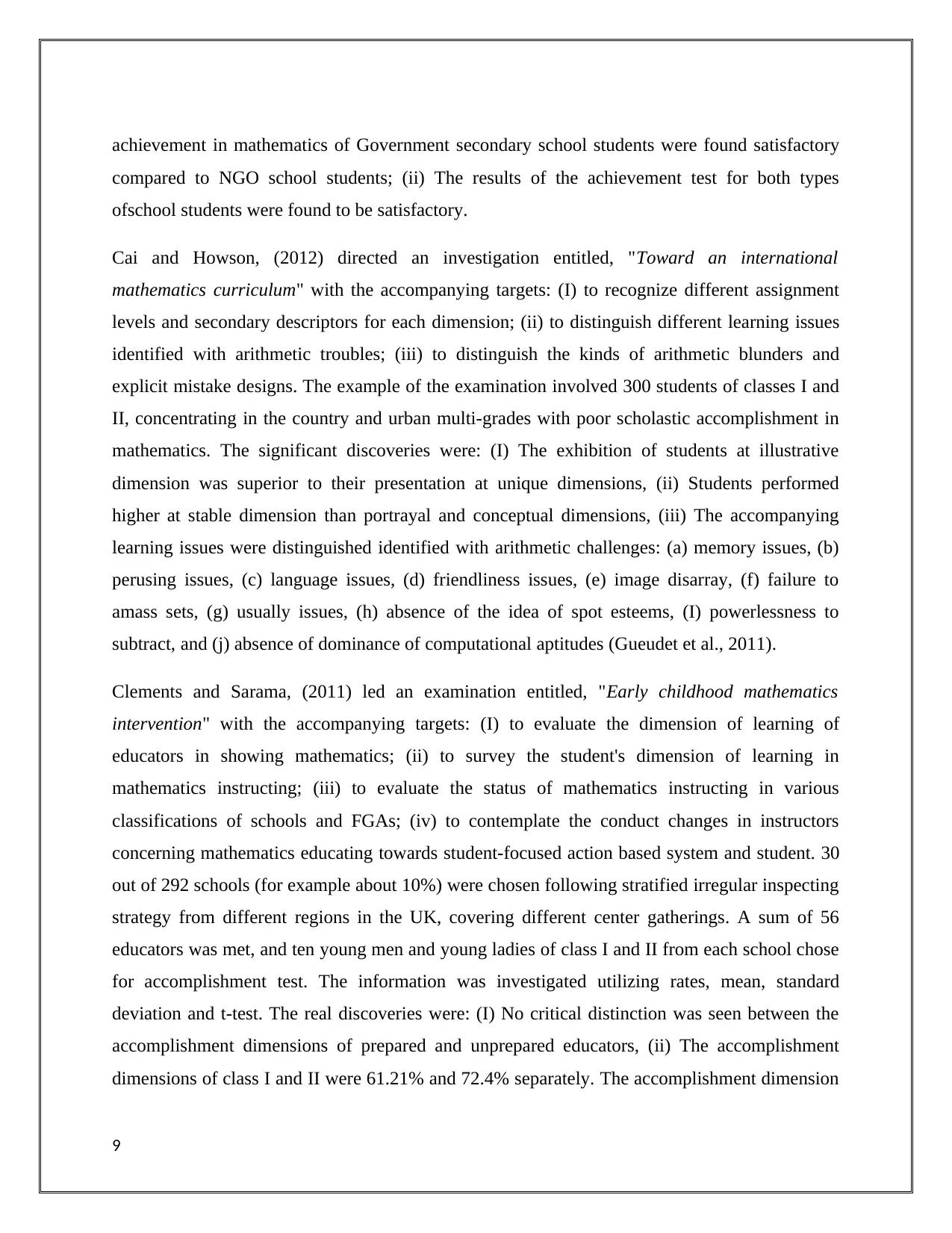
achievement in mathematics of Government secondary school students were found satisfactory
compared to NGO school students; (ii) The results of the achievement test for both types
ofschool students were found to be satisfactory.
Cai and Howson, (2012) directed an investigation entitled, "Toward an international
mathematics curriculum" with the accompanying targets: (I) to recognize different assignment
levels and secondary descriptors for each dimension; (ii) to distinguish different learning issues
identified with arithmetic troubles; (iii) to distinguish the kinds of arithmetic blunders and
explicit mistake designs. The example of the examination involved 300 students of classes I and
II, concentrating in the country and urban multi-grades with poor scholastic accomplishment in
mathematics. The significant discoveries were: (I) The exhibition of students at illustrative
dimension was superior to their presentation at unique dimensions, (ii) Students performed
higher at stable dimension than portrayal and conceptual dimensions, (iii) The accompanying
learning issues were distinguished identified with arithmetic challenges: (a) memory issues, (b)
perusing issues, (c) language issues, (d) friendliness issues, (e) image disarray, (f) failure to
amass sets, (g) usually issues, (h) absence of the idea of spot esteems, (I) powerlessness to
subtract, and (j) absence of dominance of computational aptitudes (Gueudet et al., 2011).
Clements and Sarama, (2011) led an examination entitled, "Early childhood mathematics
intervention" with the accompanying targets: (I) to evaluate the dimension of learning of
educators in showing mathematics; (ii) to survey the student's dimension of learning in
mathematics instructing; (iii) to evaluate the status of mathematics instructing in various
classifications of schools and FGAs; (iv) to contemplate the conduct changes in instructors
concerning mathematics educating towards student-focused action based system and student. 30
out of 292 schools (for example about 10%) were chosen following stratified irregular inspecting
strategy from different regions in the UK, covering different center gatherings. A sum of 56
educators was met, and ten young men and young ladies of class I and II from each school chose
for accomplishment test. The information was investigated utilizing rates, mean, standard
deviation and t-test. The real discoveries were: (I) No critical distinction was seen between the
accomplishment dimensions of prepared and unprepared educators, (ii) The accomplishment
dimensions of class I and II were 61.21% and 72.4% separately. The accomplishment dimension
9
compared to NGO school students; (ii) The results of the achievement test for both types
ofschool students were found to be satisfactory.
Cai and Howson, (2012) directed an investigation entitled, "Toward an international
mathematics curriculum" with the accompanying targets: (I) to recognize different assignment
levels and secondary descriptors for each dimension; (ii) to distinguish different learning issues
identified with arithmetic troubles; (iii) to distinguish the kinds of arithmetic blunders and
explicit mistake designs. The example of the examination involved 300 students of classes I and
II, concentrating in the country and urban multi-grades with poor scholastic accomplishment in
mathematics. The significant discoveries were: (I) The exhibition of students at illustrative
dimension was superior to their presentation at unique dimensions, (ii) Students performed
higher at stable dimension than portrayal and conceptual dimensions, (iii) The accompanying
learning issues were distinguished identified with arithmetic challenges: (a) memory issues, (b)
perusing issues, (c) language issues, (d) friendliness issues, (e) image disarray, (f) failure to
amass sets, (g) usually issues, (h) absence of the idea of spot esteems, (I) powerlessness to
subtract, and (j) absence of dominance of computational aptitudes (Gueudet et al., 2011).
Clements and Sarama, (2011) led an examination entitled, "Early childhood mathematics
intervention" with the accompanying targets: (I) to evaluate the dimension of learning of
educators in showing mathematics; (ii) to survey the student's dimension of learning in
mathematics instructing; (iii) to evaluate the status of mathematics instructing in various
classifications of schools and FGAs; (iv) to contemplate the conduct changes in instructors
concerning mathematics educating towards student-focused action based system and student. 30
out of 292 schools (for example about 10%) were chosen following stratified irregular inspecting
strategy from different regions in the UK, covering different center gatherings. A sum of 56
educators was met, and ten young men and young ladies of class I and II from each school chose
for accomplishment test. The information was investigated utilizing rates, mean, standard
deviation and t-test. The real discoveries were: (I) No critical distinction was seen between the
accomplishment dimensions of prepared and unprepared educators, (ii) The accomplishment
dimensions of class I and II were 61.21% and 72.4% separately. The accomplishment dimension
9
⊘ This is a preview!⊘
Do you want full access?
Subscribe today to unlock all pages.

Trusted by 1+ million students worldwide
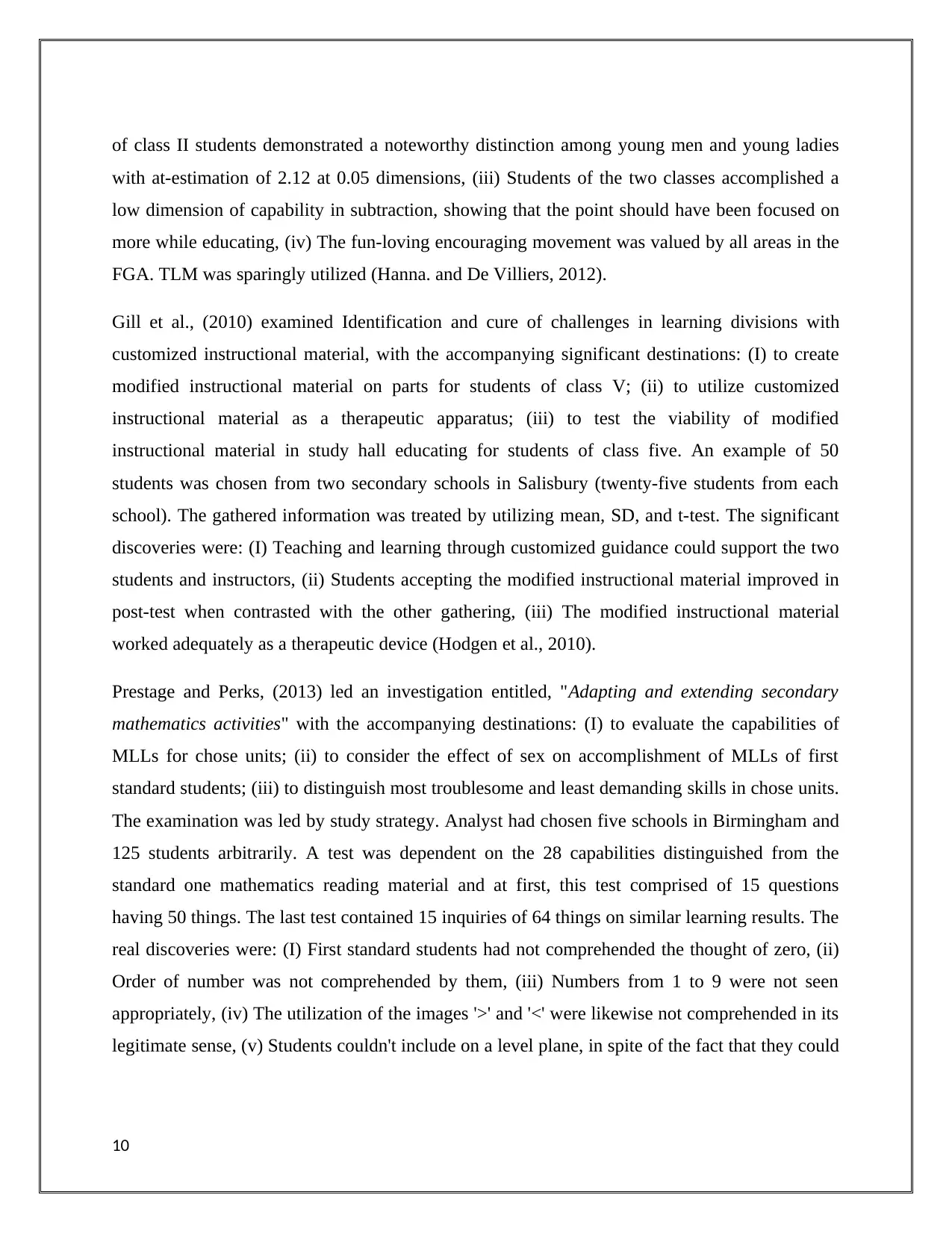
of class II students demonstrated a noteworthy distinction among young men and young ladies
with at-estimation of 2.12 at 0.05 dimensions, (iii) Students of the two classes accomplished a
low dimension of capability in subtraction, showing that the point should have been focused on
more while educating, (iv) The fun-loving encouraging movement was valued by all areas in the
FGA. TLM was sparingly utilized (Hanna. and De Villiers, 2012).
Gill et al., (2010) examined Identification and cure of challenges in learning divisions with
customized instructional material, with the accompanying significant destinations: (I) to create
modified instructional material on parts for students of class V; (ii) to utilize customized
instructional material as a therapeutic apparatus; (iii) to test the viability of modified
instructional material in study hall educating for students of class five. An example of 50
students was chosen from two secondary schools in Salisbury (twenty-five students from each
school). The gathered information was treated by utilizing mean, SD, and t-test. The significant
discoveries were: (I) Teaching and learning through customized guidance could support the two
students and instructors, (ii) Students accepting the modified instructional material improved in
post-test when contrasted with the other gathering, (iii) The modified instructional material
worked adequately as a therapeutic device (Hodgen et al., 2010).
Prestage and Perks, (2013) led an investigation entitled, "Adapting and extending secondary
mathematics activities" with the accompanying destinations: (I) to evaluate the capabilities of
MLLs for chose units; (ii) to consider the effect of sex on accomplishment of MLLs of first
standard students; (iii) to distinguish most troublesome and least demanding skills in chose units.
The examination was led by study strategy. Analyst had chosen five schools in Birmingham and
125 students arbitrarily. A test was dependent on the 28 capabilities distinguished from the
standard one mathematics reading material and at first, this test comprised of 15 questions
having 50 things. The last test contained 15 inquiries of 64 things on similar learning results. The
real discoveries were: (I) First standard students had not comprehended the thought of zero, (ii)
Order of number was not comprehended by them, (iii) Numbers from 1 to 9 were not seen
appropriately, (iv) The utilization of the images '>' and '<' were likewise not comprehended in its
legitimate sense, (v) Students couldn't include on a level plane, in spite of the fact that they could
10
with at-estimation of 2.12 at 0.05 dimensions, (iii) Students of the two classes accomplished a
low dimension of capability in subtraction, showing that the point should have been focused on
more while educating, (iv) The fun-loving encouraging movement was valued by all areas in the
FGA. TLM was sparingly utilized (Hanna. and De Villiers, 2012).
Gill et al., (2010) examined Identification and cure of challenges in learning divisions with
customized instructional material, with the accompanying significant destinations: (I) to create
modified instructional material on parts for students of class V; (ii) to utilize customized
instructional material as a therapeutic apparatus; (iii) to test the viability of modified
instructional material in study hall educating for students of class five. An example of 50
students was chosen from two secondary schools in Salisbury (twenty-five students from each
school). The gathered information was treated by utilizing mean, SD, and t-test. The significant
discoveries were: (I) Teaching and learning through customized guidance could support the two
students and instructors, (ii) Students accepting the modified instructional material improved in
post-test when contrasted with the other gathering, (iii) The modified instructional material
worked adequately as a therapeutic device (Hodgen et al., 2010).
Prestage and Perks, (2013) led an investigation entitled, "Adapting and extending secondary
mathematics activities" with the accompanying destinations: (I) to evaluate the capabilities of
MLLs for chose units; (ii) to consider the effect of sex on accomplishment of MLLs of first
standard students; (iii) to distinguish most troublesome and least demanding skills in chose units.
The examination was led by study strategy. Analyst had chosen five schools in Birmingham and
125 students arbitrarily. A test was dependent on the 28 capabilities distinguished from the
standard one mathematics reading material and at first, this test comprised of 15 questions
having 50 things. The last test contained 15 inquiries of 64 things on similar learning results. The
real discoveries were: (I) First standard students had not comprehended the thought of zero, (ii)
Order of number was not comprehended by them, (iii) Numbers from 1 to 9 were not seen
appropriately, (iv) The utilization of the images '>' and '<' were likewise not comprehended in its
legitimate sense, (v) Students couldn't include on a level plane, in spite of the fact that they could
10
Paraphrase This Document
Need a fresh take? Get an instant paraphrase of this document with our AI Paraphraser
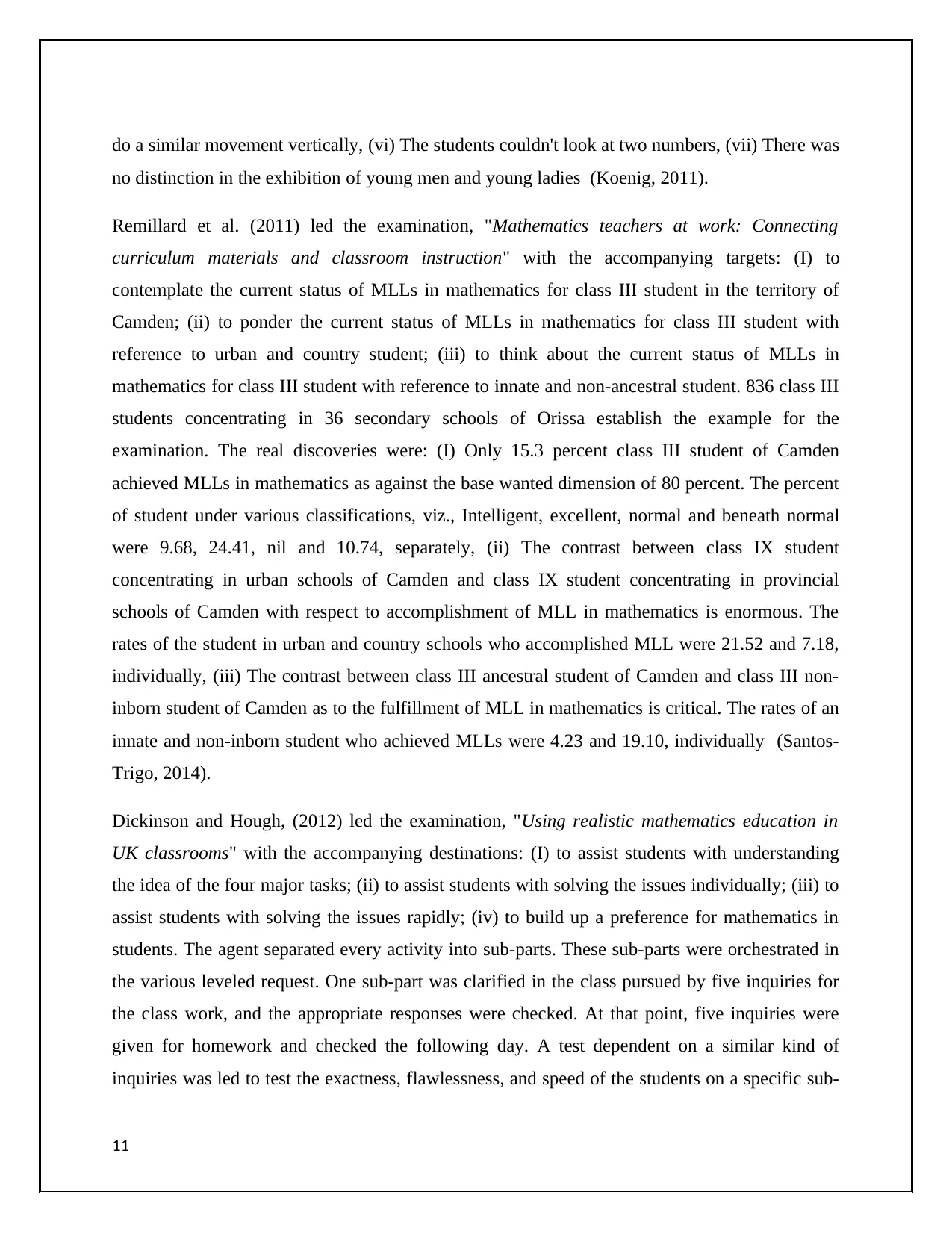
do a similar movement vertically, (vi) The students couldn't look at two numbers, (vii) There was
no distinction in the exhibition of young men and young ladies (Koenig, 2011).
Remillard et al. (2011) led the examination, "Mathematics teachers at work: Connecting
curriculum materials and classroom instruction" with the accompanying targets: (I) to
contemplate the current status of MLLs in mathematics for class III student in the territory of
Camden; (ii) to ponder the current status of MLLs in mathematics for class III student with
reference to urban and country student; (iii) to think about the current status of MLLs in
mathematics for class III student with reference to innate and non-ancestral student. 836 class III
students concentrating in 36 secondary schools of Orissa establish the example for the
examination. The real discoveries were: (I) Only 15.3 percent class III student of Camden
achieved MLLs in mathematics as against the base wanted dimension of 80 percent. The percent
of student under various classifications, viz., Intelligent, excellent, normal and beneath normal
were 9.68, 24.41, nil and 10.74, separately, (ii) The contrast between class IX student
concentrating in urban schools of Camden and class IX student concentrating in provincial
schools of Camden with respect to accomplishment of MLL in mathematics is enormous. The
rates of the student in urban and country schools who accomplished MLL were 21.52 and 7.18,
individually, (iii) The contrast between class III ancestral student of Camden and class III non-
inborn student of Camden as to the fulfillment of MLL in mathematics is critical. The rates of an
innate and non-inborn student who achieved MLLs were 4.23 and 19.10, individually (Santos-
Trigo, 2014).
Dickinson and Hough, (2012) led the examination, "Using realistic mathematics education in
UK classrooms" with the accompanying destinations: (I) to assist students with understanding
the idea of the four major tasks; (ii) to assist students with solving the issues individually; (iii) to
assist students with solving the issues rapidly; (iv) to build up a preference for mathematics in
students. The agent separated every activity into sub-parts. These sub-parts were orchestrated in
the various leveled request. One sub-part was clarified in the class pursued by five inquiries for
the class work, and the appropriate responses were checked. At that point, five inquiries were
given for homework and checked the following day. A test dependent on a similar kind of
inquiries was led to test the exactness, flawlessness, and speed of the students on a specific sub-
11
no distinction in the exhibition of young men and young ladies (Koenig, 2011).
Remillard et al. (2011) led the examination, "Mathematics teachers at work: Connecting
curriculum materials and classroom instruction" with the accompanying targets: (I) to
contemplate the current status of MLLs in mathematics for class III student in the territory of
Camden; (ii) to ponder the current status of MLLs in mathematics for class III student with
reference to urban and country student; (iii) to think about the current status of MLLs in
mathematics for class III student with reference to innate and non-ancestral student. 836 class III
students concentrating in 36 secondary schools of Orissa establish the example for the
examination. The real discoveries were: (I) Only 15.3 percent class III student of Camden
achieved MLLs in mathematics as against the base wanted dimension of 80 percent. The percent
of student under various classifications, viz., Intelligent, excellent, normal and beneath normal
were 9.68, 24.41, nil and 10.74, separately, (ii) The contrast between class IX student
concentrating in urban schools of Camden and class IX student concentrating in provincial
schools of Camden with respect to accomplishment of MLL in mathematics is enormous. The
rates of the student in urban and country schools who accomplished MLL were 21.52 and 7.18,
individually, (iii) The contrast between class III ancestral student of Camden and class III non-
inborn student of Camden as to the fulfillment of MLL in mathematics is critical. The rates of an
innate and non-inborn student who achieved MLLs were 4.23 and 19.10, individually (Santos-
Trigo, 2014).
Dickinson and Hough, (2012) led the examination, "Using realistic mathematics education in
UK classrooms" with the accompanying destinations: (I) to assist students with understanding
the idea of the four major tasks; (ii) to assist students with solving the issues individually; (iii) to
assist students with solving the issues rapidly; (iv) to build up a preference for mathematics in
students. The agent separated every activity into sub-parts. These sub-parts were orchestrated in
the various leveled request. One sub-part was clarified in the class pursued by five inquiries for
the class work, and the appropriate responses were checked. At that point, five inquiries were
given for homework and checked the following day. A test dependent on a similar kind of
inquiries was led to test the exactness, flawlessness, and speed of the students on a specific sub-
11
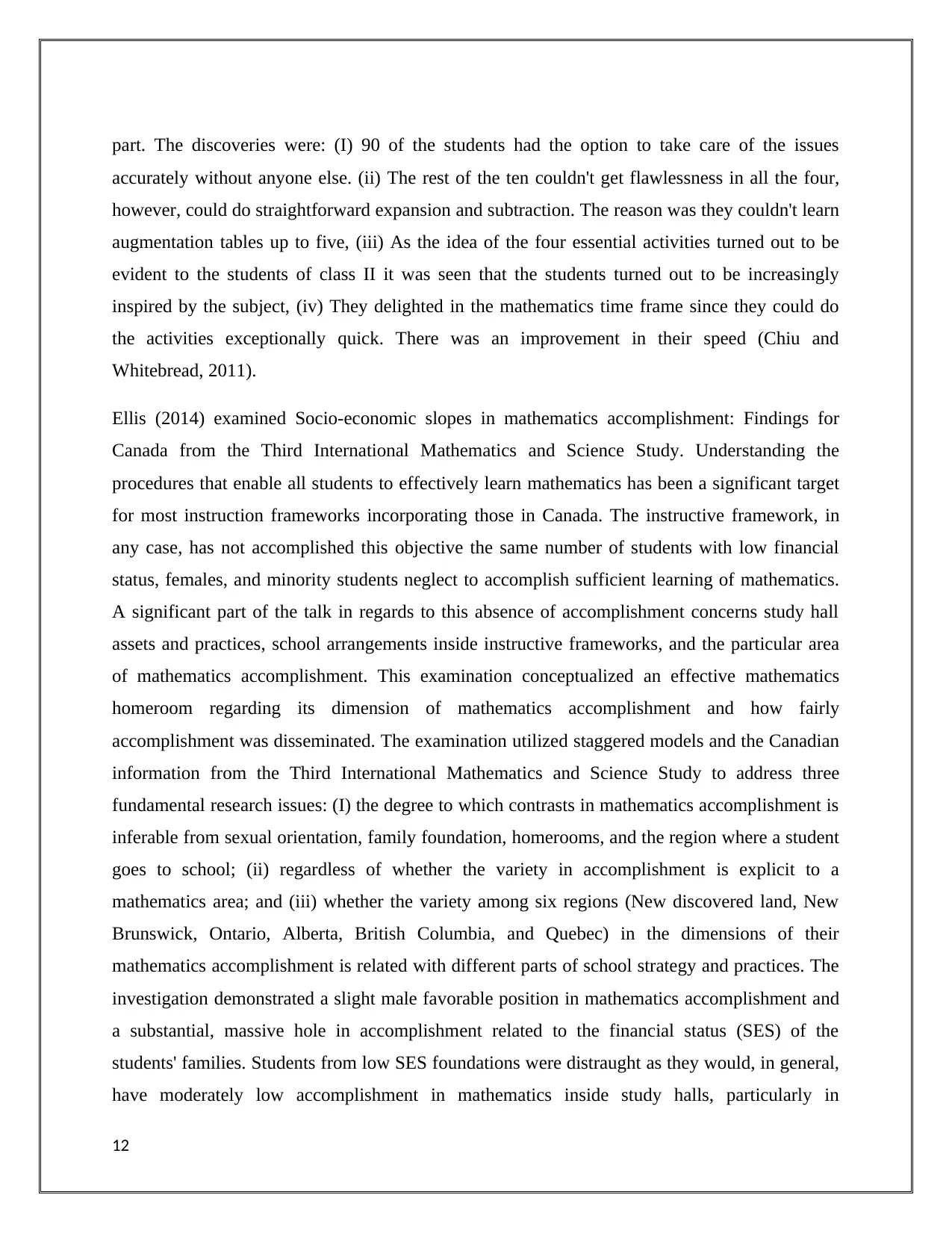
part. The discoveries were: (I) 90 of the students had the option to take care of the issues
accurately without anyone else. (ii) The rest of the ten couldn't get flawlessness in all the four,
however, could do straightforward expansion and subtraction. The reason was they couldn't learn
augmentation tables up to five, (iii) As the idea of the four essential activities turned out to be
evident to the students of class II it was seen that the students turned out to be increasingly
inspired by the subject, (iv) They delighted in the mathematics time frame since they could do
the activities exceptionally quick. There was an improvement in their speed (Chiu and
Whitebread, 2011).
Ellis (2014) examined Socio-economic slopes in mathematics accomplishment: Findings for
Canada from the Third International Mathematics and Science Study. Understanding the
procedures that enable all students to effectively learn mathematics has been a significant target
for most instruction frameworks incorporating those in Canada. The instructive framework, in
any case, has not accomplished this objective the same number of students with low financial
status, females, and minority students neglect to accomplish sufficient learning of mathematics.
A significant part of the talk in regards to this absence of accomplishment concerns study hall
assets and practices, school arrangements inside instructive frameworks, and the particular area
of mathematics accomplishment. This examination conceptualized an effective mathematics
homeroom regarding its dimension of mathematics accomplishment and how fairly
accomplishment was disseminated. The examination utilized staggered models and the Canadian
information from the Third International Mathematics and Science Study to address three
fundamental research issues: (I) the degree to which contrasts in mathematics accomplishment is
inferable from sexual orientation, family foundation, homerooms, and the region where a student
goes to school; (ii) regardless of whether the variety in accomplishment is explicit to a
mathematics area; and (iii) whether the variety among six regions (New discovered land, New
Brunswick, Ontario, Alberta, British Columbia, and Quebec) in the dimensions of their
mathematics accomplishment is related with different parts of school strategy and practices. The
investigation demonstrated a slight male favorable position in mathematics accomplishment and
a substantial, massive hole in accomplishment related to the financial status (SES) of the
students' families. Students from low SES foundations were distraught as they would, in general,
have moderately low accomplishment in mathematics inside study halls, particularly in
12
accurately without anyone else. (ii) The rest of the ten couldn't get flawlessness in all the four,
however, could do straightforward expansion and subtraction. The reason was they couldn't learn
augmentation tables up to five, (iii) As the idea of the four essential activities turned out to be
evident to the students of class II it was seen that the students turned out to be increasingly
inspired by the subject, (iv) They delighted in the mathematics time frame since they could do
the activities exceptionally quick. There was an improvement in their speed (Chiu and
Whitebread, 2011).
Ellis (2014) examined Socio-economic slopes in mathematics accomplishment: Findings for
Canada from the Third International Mathematics and Science Study. Understanding the
procedures that enable all students to effectively learn mathematics has been a significant target
for most instruction frameworks incorporating those in Canada. The instructive framework, in
any case, has not accomplished this objective the same number of students with low financial
status, females, and minority students neglect to accomplish sufficient learning of mathematics.
A significant part of the talk in regards to this absence of accomplishment concerns study hall
assets and practices, school arrangements inside instructive frameworks, and the particular area
of mathematics accomplishment. This examination conceptualized an effective mathematics
homeroom regarding its dimension of mathematics accomplishment and how fairly
accomplishment was disseminated. The examination utilized staggered models and the Canadian
information from the Third International Mathematics and Science Study to address three
fundamental research issues: (I) the degree to which contrasts in mathematics accomplishment is
inferable from sexual orientation, family foundation, homerooms, and the region where a student
goes to school; (ii) regardless of whether the variety in accomplishment is explicit to a
mathematics area; and (iii) whether the variety among six regions (New discovered land, New
Brunswick, Ontario, Alberta, British Columbia, and Quebec) in the dimensions of their
mathematics accomplishment is related with different parts of school strategy and practices. The
investigation demonstrated a slight male favorable position in mathematics accomplishment and
a substantial, massive hole in accomplishment related to the financial status (SES) of the
students' families. Students from low SES foundations were distraught as they would, in general,
have moderately low accomplishment in mathematics inside study halls, particularly in
12
⊘ This is a preview!⊘
Do you want full access?
Subscribe today to unlock all pages.

Trusted by 1+ million students worldwide
1 out of 36
Your All-in-One AI-Powered Toolkit for Academic Success.
+13062052269
info@desklib.com
Available 24*7 on WhatsApp / Email
![[object Object]](/_next/static/media/star-bottom.7253800d.svg)
Unlock your academic potential
Copyright © 2020–2025 A2Z Services. All Rights Reserved. Developed and managed by ZUCOL.